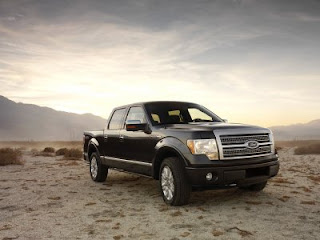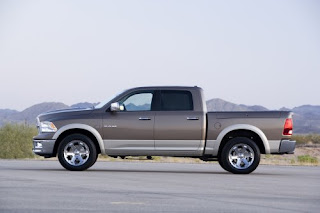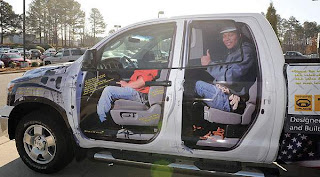Different Tactics Used to Sell Full-Size Pickups in a Collapsing Market
 Sales of full-size pickups (the Ford F-series, Chevrolet Silverado, GMC Sierra, Dodge Ram, Toyota Tundra, and Nissan Titan) dropped 22.1% in April and are down 16.6% through the first third of 2008. This segment has suffered even worse than the overall US light vehicle market so far in 2008, which is down 7.7% through April 30.
Sales of full-size pickups (the Ford F-series, Chevrolet Silverado, GMC Sierra, Dodge Ram, Toyota Tundra, and Nissan Titan) dropped 22.1% in April and are down 16.6% through the first third of 2008. This segment has suffered even worse than the overall US light vehicle market so far in 2008, which is down 7.7% through April 30.
Part of the problem is, of course, gas prices. As people who bought trucks as “lifestyle” vehicles or fashion statements in recent years because they “always get stuff from Home Depot” or “like the space” of a crew cab pickup begin to reconsider whether they actually need to commute to work in a 13 mile-per-gallon behemoth when a 25 mile per gallon sedan might do the trick 99% of the time, many of these folks are not replacing their old pickups with new ones. Instead, they are replacing them with much smaller cars. Chrysler is trying to address fuel price concerns by agreeing to lock in gas prices at $2.99 per gallon for the first three years, but that is only one of the creative ways that Detroit and Japan are fighting market currents in this segment that are rushing against them.
 In addition to the collapsing market for large pickups, there are other factors at play. Both Ford and Dodge are introducing all-new 2009 models of their flagship pickups later this year, so they are forced to heavily incent their old-style 2008 models in the meantime to clear out the lots, until the 2009s arrive. Also, Toyota has a lot more plant capacity to build Tundras in its Princeton, Indiana and San Antonio, Texas plants than it is currently utilizing. Toyota can build over 300,000 Tundras per year, but was hoping to sell 200,000 this year. They’re behind even the 200,000 pace so far this year and have more units in inventory than they’d like to see.
In addition to the collapsing market for large pickups, there are other factors at play. Both Ford and Dodge are introducing all-new 2009 models of their flagship pickups later this year, so they are forced to heavily incent their old-style 2008 models in the meantime to clear out the lots, until the 2009s arrive. Also, Toyota has a lot more plant capacity to build Tundras in its Princeton, Indiana and San Antonio, Texas plants than it is currently utilizing. Toyota can build over 300,000 Tundras per year, but was hoping to sell 200,000 this year. They’re behind even the 200,000 pace so far this year and have more units in inventory than they’d like to see.
Against this backdrop – nearly a perfect storm, if you will, of bad news for the truck segment – dealers and manufacturers have resorted to some creative (and expensive, in some cases) ways to move the metal.
According to Automotive News, some Dodge dealers in California are advertising Ram 1500 Quad Cab SLT 4×2 for $19,995, or $12,800 below its MSRP of $32,795. A competing dealer also in Sacramento is offering an even $13,000 off the same truck. Throw in three years of subsidized gasoline, and that’s a pretty decent deal on a solid truck, even if it’s about to become an obsolete model. Imagine for a moment what cutting 40% off the asking price of a new truck does for the resale values of Rams already on the road.
 Toyota is also undertaking a grassroots-type effort to sell Tundras. Rather than using a national advertising push for the Tundra, the company’s dealers are trying creative sponsorships and product demonstrations to impress upon potential customers that they are selling a credible, capable truck. Some dealers sponsor high school football games, offer free lunches and tours of the Tundra at Home Depot, or give a free lawn tractor with the purchase of a new pickup. Automotive News reported also that one dealer in Raleigh, North Carolina allows contractors to borrow a modified Tundra DoubleCab with “invisible” doors (really just decals that show what’s underneath) to show what lies beneath the Tundra’s sheetmetal. Some of that sheetmetal, by the way, is also covered in see-through decals. It’s an interesting look, and certainly surprising to see it actually driven on public roads instead of just a cutaway static display in a dealer’s showroom.
Toyota is also undertaking a grassroots-type effort to sell Tundras. Rather than using a national advertising push for the Tundra, the company’s dealers are trying creative sponsorships and product demonstrations to impress upon potential customers that they are selling a credible, capable truck. Some dealers sponsor high school football games, offer free lunches and tours of the Tundra at Home Depot, or give a free lawn tractor with the purchase of a new pickup. Automotive News reported also that one dealer in Raleigh, North Carolina allows contractors to borrow a modified Tundra DoubleCab with “invisible” doors (really just decals that show what’s underneath) to show what lies beneath the Tundra’s sheetmetal. Some of that sheetmetal, by the way, is also covered in see-through decals. It’s an interesting look, and certainly surprising to see it actually driven on public roads instead of just a cutaway static display in a dealer’s showroom.
Toyota’s regional offices give dealers co-op marketing money to be used for local promotions, and often provide them with additional ideas along with the money to allow for even more creative marketing ideas.
GM finds itself in a bit of a different situation; its pickups are relatively new (as is the Tundra), but is forced to compete on price and with cut-rate financing (everyone offers rates as low as 0%) when other manufacturers have different needs such as reducing excess inventory or ramping up production of the next-generation models. The American Axle strike has put a crimp on GM’s large truck production, but handily enough for GM, the company still has thousands of trucks in inventory, even as the strike has gone past the two month mark.
For contrarian consumers – those who would rather pay more money for fuel and less money upfront for their vehicle purchase – or those who actually do need a large pickup truck for work or family reasons (and “looks tough” does not count under the “needs” category), this is turning out to be a great time to shop for a new truck. The deals are great, and may just get better by the end of the year as Ford and Chrysler have their new 2009s on dealer lots, and there is barely any room for them amidst a sea of unsold 2008s.




